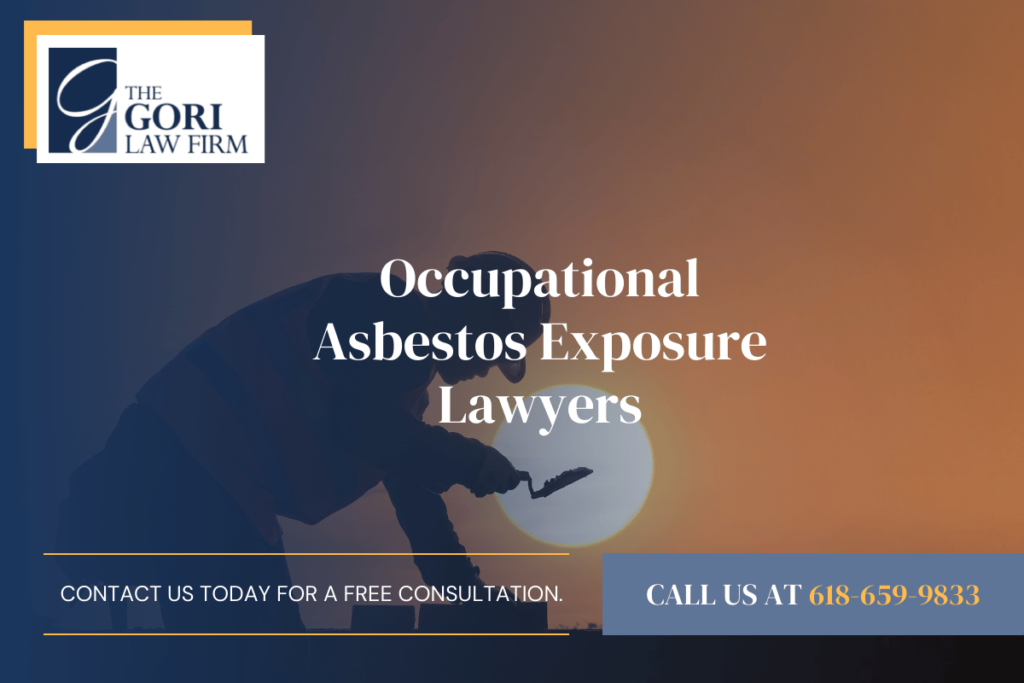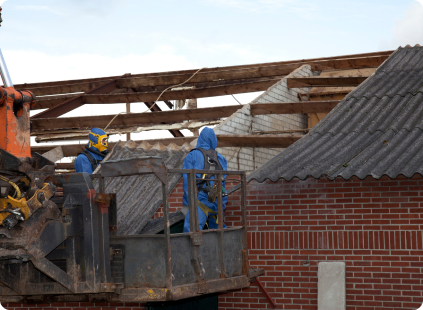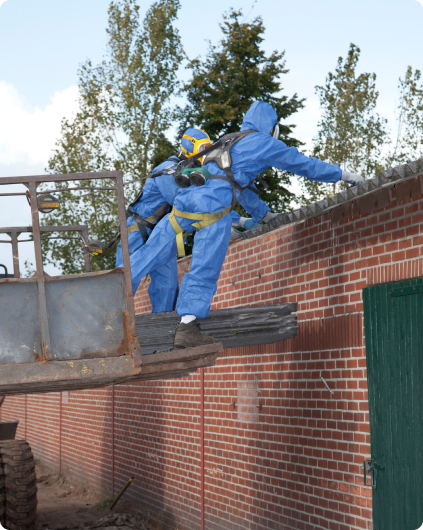Nationwide Occupational Asbestos Exposure Law Firm


- Your past occupations may have brought you in contact with asbestos, especially if you’ve been diagnosed with mesothelioma.
- Occupational asbestos exposure is surprisingly common, with workers in construction, manufacturing, and other blue-collar jobs facing the highest risk.
- If you are a victim of occupational asbestos exposure, you may be able to pursue legal avenues such as workers’ compensation claims, civil lawsuits, or asbestos trust funds to recover monetary compensation for your hardship.
- An attorney with experience representing victims of mesothelioma and occupational asbestos exposure can help you determine your next steps and pursue legal action if appropriate.
Navigate this page
- How Much Compensation Can You Get for Occupational Asbestos Exposure?
- Why Choose The Gori Law Firm for Your Occupational Mesothelioma Case?
- What Is Occupational Asbestos Exposure?
- Which Jobs Are at the Most Risk for Asbestos Exposure?
- Are Workers Still Exposed to Asbestos Today?
- How Are Workers Protected From Occupational Asbestos Exposure?
How Much Compensation Can You Get for Occupational Asbestos Exposure?
If you have been diagnosed with an asbestos-related illness, such as mesothelioma, due to asbestos exposure in the workplace, you may be entitled to compensation. The amount of compensation you can receive through an asbestos or mesothelioma claim depends on several factors, including the severity of your illness, the source of your exposure, and the type of compensation you pursue. Pursuing more than one type of compensation may increase the amount you receive.

Contact Us Today
Get your free case review 24 hours a day.
Fields marked with an * are required
Workers' Compensation
Most employers in the United States carry workers’ compensation insurance, which provides benefits to employees who are injured or become ill while performing their work duties. These benefits typically include medical expenses, lost wages, and rehabilitation costs.
There may be limits to the amount you can recover for certain types of benefits, with some states capping the lost wages benefit at a certain percentage of the employee’s pre-injury income.
Lawsuits
You may have the option to file a lawsuit against the party responsible for exposing you to asbestos. Potentially responsible parties include asbestos product manufacturers or distributors, property owners, or contractors.
Civil lawsuits typically allow for the recovery of a wider array of damages than are available through workers’ compensation, leading to higher settlement or verdict amounts. Damages could include medical expenses, lost wages, pain and suffering, and punitive damages intended to punish the responsible party for their actions.
Asbestos Trust Funds
As lawsuits over asbestos exposure have mounted, many asbestos companies have filed for bankruptcy protection. Courts have required that these companies set aside funds to compensate victims of exposure to their products. These trust funds have set aside billions of dollars for this purpose.
If a company that has established a trust fund is responsible for your exposure, you could receive compensation for your losses without filing a formal lawsuit.
Speak with a Mesothelioma Lawyer Today.
Let Us Help You With Your Financial
Help & Compensation Options
Why Choose The Gori Law Firm for Your
Occupational Mesothelioma Case?
Mesothelioma and asbestos cases require a unique blend of skill, compassion, and expertise. The Gori Law Firm stands as a beacon of hope for those whose lives have been affected by occupational exposure to asbestos. With over $4 billion recovered for our clients and decades of asbestos-focused experience, we are a recognized nationwide leader in mesothelioma and asbestos litigation.
Often, the greatest challenge in asbestos cases is determining when and where exposure occurred, as occupational asbestos exposure tends to occur decades before symptoms appear. Our extensive database of sites, products, and occupations known for asbestos exposure equips us to identify the parties responsible for your illness and pursue all available avenues of compensation. When you turn to our team, we’ll get to know you, your story, and your individual needs so that we can provide tailored service to help you pursue the resources you need to support yourself and your family.
If you or a loved one has developed mesothelioma as a result of occupational and environmental exposure to asbestos, contact The Gori Law Firm today for a free consultation.
You may be eligible for significant compensation that The Gori Law Firm can fight for on your behalf.
What Is Occupational Asbestos Exposure?
Occupational asbestos exposure refers to the inhalation or ingestion of asbestos fibers that occurs in a work environment.
Asbestos is a naturally occurring mineral once widely used in various industries due to its heat resistance and strength. When disturbed, asbestos fibers can become airborne and easily inhaled or ingested, which poses a major health risk to workers who are exposed to asbestos regularly. Diseases often associated with asbestos exposure include the following:
- Mesothelioma
- Lung cancer
- Asbestosis
- Pleural disease
- Laryngeal cancer
- Ovarian cancer
Widespread asbestos use started to dwindle in the 1970s after experts began to recognize the serious health risks associated with exposure. However, affected workers continue to feel the effects of occupational asbestos exposure today, as the latency period for asbestos-related diseases can range from 10-40 years. This means that individuals who worked in occupations at risk for asbestos exposure decades ago may just now be developing symptoms or receiving a diagnosis.
In addition, while asbestos use has been phased out in most industries, the material is still present in many buildings and products. Thus, workers may still be exposed to the material on the job.
Quick Facts: Occupational Asbestos Exposure
- Work-related asbestos exposure causes approximately 233,000 deaths globally each year.
- An estimated 27 million workers in the U.S. were exposed to airborne asbestos fibers between 1940 and 1979.
- At least 1.3 million American workers continue to face occupational asbestos exposure today, particularly in the construction industry.
Which Jobs Are at the Most Risk for Asbestos Exposure?
Any job that involves handling or working around asbestos-containing materials poses a risk for occupational exposure. The risk is particularly high for jobs involving tasks that disturb asbestos-containing products. In the past, occupations with a high risk of asbestos exposure included mining or milling raw asbestos material, construction work, and manufacturing of asbestos-containing products.
Some of the most common include:
Today, workers in industries like construction, shipbuilding, automotive repair, and plumbing are still at risk for exposure due to the potential presence of asbestos-containing materials in older buildings and products.
Additionally, firefighters and first responders who enter older asbestos-containing buildings during emergencies may also be at risk for occupational exposure. Those who responded to the collapse of the World Trade Center on 9/11 and its aftermath have been found to have exceptionally high rates of asbestos-related since massive amounts of asbestos were released into the air.
Veterans who served in the military are also at risk for occupational asbestos exposure, particularly Coast Guard and Navy veterans who worked on ships or in shipyards, where asbestos was extensively used. Electricians, pipefitters, and mechanics in the military may have also been exposed to asbestos-containing materials during their service.
Are Workers Still Exposed to Asbestos Today?
U.S. asbestos use dropped from 803,000 metric tons to only 360 metric tons between 1973 and 2015. This decline is primarily due to increased regulations partially banning asbestos use in many of its former applications.
Unfortunately, asbestos is not completely banned in the U.S. Some products are still made with asbestos when a reasonable substitute material is unavailable. Additionally, many older buildings still contain asbestos-containing materials, which can pose an exposure risk to workers performing renovations or demolitions.
U.S. lawmakers proposed a ban on all remaining asbestos use and importation in 2023, but it has yet to be enacted. The U.S. Environmental Protection Agency previously issued a rule banning asbestos in 1989. However, a federal appeals court overturned the ban in 1991.

How Are Workers Protected From
Occupational Asbestos Exposure?
The Occupational Safety and Health Administration is responsible for setting workplace safety standards and regulations in the U.S. In regards to asbestos, OSHA has established several measures to protect workers from occupational exposure to asbestos during construction work and other activities, including the following:
- Permissible Exposure Limit, or PEL: OSHA has set a PEL of 0.1 fibers per cubic centimeter of air for asbestos in the workplace over an 8-hour time-weighted average.
- Assessment and monitoring requirements: Workplaces must assess and monitor the levels of asbestos in the workplace to ensure they are below the PEL.
- Engineering controls: If asbestos levels exceed the asbestos occupational exposure limit, workplaces must use engineering controls to reduce worker asbestos exposure to the lowest level achievable.
- Hazard communication and demarcation: Workplaces must provide warning signs, prohibit smoking, eating, and drinking, and mandate personal protective equipment in areas with levels above the occupational exposure limit for asbestos.
Additionally, OSHA requires employers to keep records of worker exposure to asbestos and provide medical surveillance for workers exposed to high asbestos levels. OSHA may conduct inspections and issue penalties if it finds that a workplace is not complying with asbestos safety regulations.
Speak with a Mesothelioma Lawyer Today.
Let Us Help You With Your Financial
Help & Compensation Options
7 Sources Cited On This Page
- “Asbestos Toxicity: Who Is at Risk of Exposure to Asbestos? | Environmental Medicine | ATSDR.” Www.atsdr.cdc.gov, 9 Feb. 2021, www.atsdr.cdc.gov/csem/asbestos/who_is_at_risk.html.
- ATSDR. “Health Effects of Asbestos | Asbestos | ATSDR.” Cdc.gov, 3 Nov. 2016, www.atsdr.cdc.gov/asbestos/health_effects_asbestos.html.
- Furuya, Sugio, et al. “Global Asbestos Disaster.” International Journal of Environmental Research and Public Health, vol. 15, no. 5, 1 May 2018, www.ncbi.nlm.nih.gov/pmc/articles/PMC5982039/#app1-ijerph-15-01000, https://doi.org/10.3390/ijerph15051000.
- McGrory, Neil Bedi,Kathleen. “Lawmakers Have Renewed the Effort to Ban Asbestos.” ProPublica, 31 Mar. 2023, www.propublica.org/article/asbestos-ban-poisoning-workers-factories. Accessed 16 Feb. 2024.
- National Cancer Institute. “Asbestos Exposure and Cancer Risk Fact Sheet.” National Cancer Institute, Cancer.gov, 29 Nov. 2021, www.cancer.gov/about-cancer/causes-prevention/risk/substances/asbestos/asbestos-fact-sheet.
- “The History of Asbestos | SCDHEC.” Scdhec.gov, scdhec.gov/environment/your-home/asbestos/history-asbestos.
- https://www.osha.gov/sites/default/files/publications/OSHA3507.pdf


